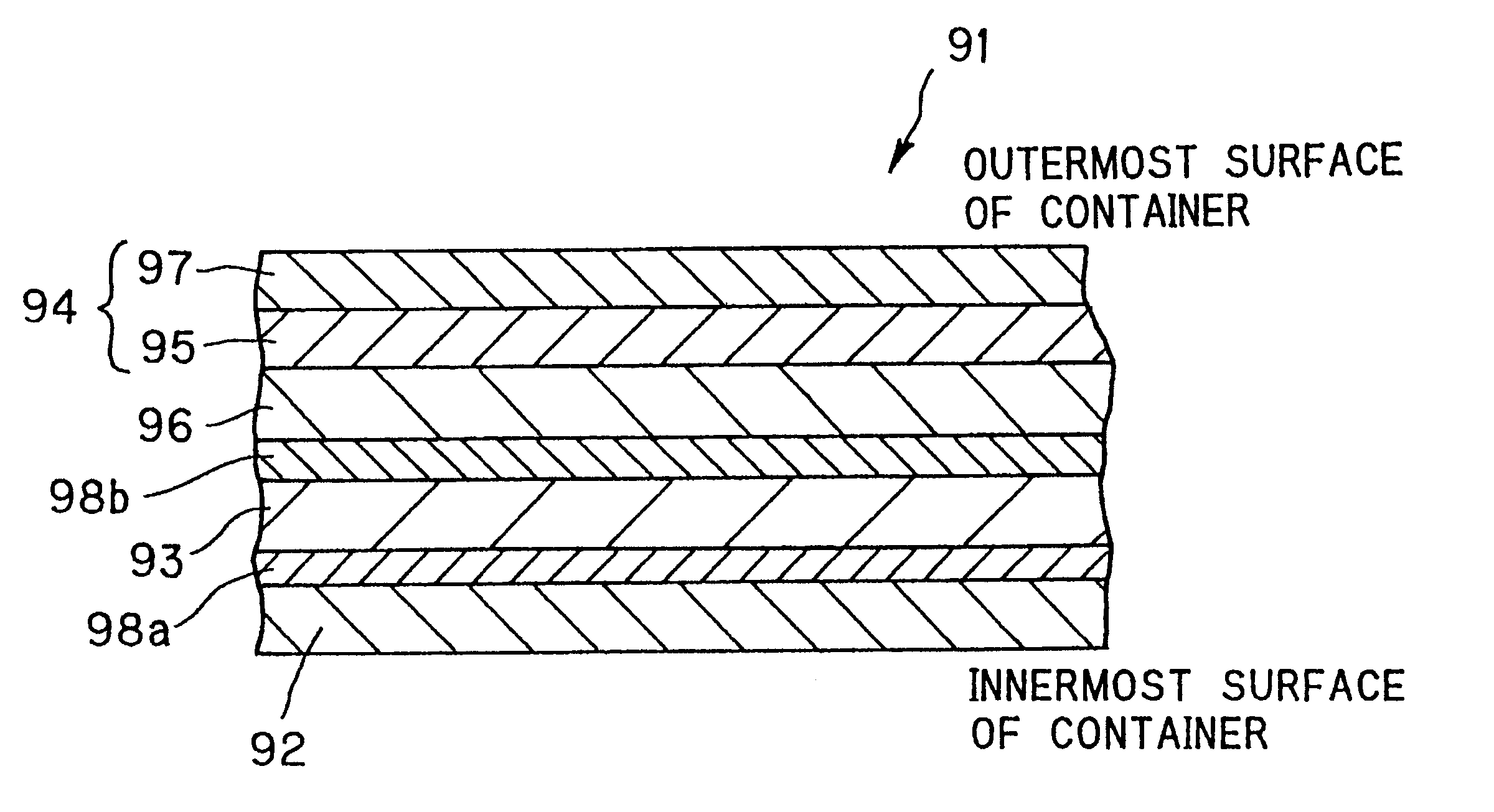Composite container having barrier property
a technology of barrier property and composite container, which is applied in the direction of transportation and packaging, other domestic articles, and cellulosic plastic layered products. it can solve the problems of insufficient strength, insufficient gas barrier property of nylon 6 layer, and inability to easily separate and coll
- Summary
- Abstract
- Description
- Claims
- Application Information
AI Technical Summary
Benefits of technology
Problems solved by technology
Method used
Image
Examples
experiment example 2
Sample 1
First, a base material layer having a three layer structure was prepared in the same manner as in the preparation of Sample 1 in Experiment Example 1.
One surface side of the resultant base material layer way subjected to a corona discharge treatment, and an isocyanate type adhesive (Takelac A310 and Takenate A 3, mfd. by Takeda Yakuhin Kogyo K.K.) was applied onto the thus treated surface to form an adhesive layer. Thereafter, on the thus formed adhesive layer, a 10 .mu.m thick barrier layer comprising a semi-aromatic polyamide resin (Novamid X21, mfd. by Mitsubishi Kasei K.K.) and a 30 .mu.m thick inner layer comprising a carboxyl group containing polyethylene resin (New Kurel 0908C, mfd. by Mitsui Du Pont Polychemical K.K.) were sequentially laminated in this order by co-extrusion laminating, thereby to provide a packaging material (Sample 1) as shown in FIG. 3.
Sample 2
First, a base material layer having a two layer structure was prepared in the same manner as in the prepa...
experiment example 3
Sample 1
First, a base material layer having a three layer structure was prepared in the same-manner as in the preparation of Sample 1 in Experiment Example 1.
Then, by use of the resultant base material layer, a packaging material (Sample 1) was prepared in the same manner as in the preparation of the above Sample 1 in Experiment Example 1 except that a semi-aromatic polyamide resin (Novamid X21, mfd. by Mitsubishi Kasei K.K.) was used as the material constituting the barrier layer.
Sample 2
A packaging material (Sample 2) was prepared in the same manner as in the preparation of the above Sample 2 in the Experiment Example 1 except that a co-extrusion film having the following structure was used instead of that used in Sample 2 of Experiment Example 1.
Structure of Co-extrusion Film (Thickness: 40 .lambda.m)
low density polyethylene (thickness: 10 .mu.m) / adhesive polyethylene (thickness: 5 .mu.m) / semi-aromatic polyamide resin (thickness: 10 .mu.m) / adhesive polyethylene (thickness: 5 m) / l...
experiment example 4
Sample 1
First, a base material layer having a three layer structure was prepared in the same manner as in the preparation of Sample 1 in Experiment Example 1
One surface side of the resultant base material layer is subjected to a corona discharge treatment, and on the thus treated surface, a 10 .mu.m thick adhesive layer comprising an adhesive polyolefin resin (Addmer AT 499, mfd. by Mitsui Sekiyu Kagaku Kogyo K.K.), and a 10 .mu.m thick inner layer having a barrier property and comprising a semi-aromatic polyamide resin (Novamid X21, mfd. by Mitsubishi Kasei K.K.), were sequentially laminated in this order by co-extrusion laminating, thereby to provide a packaging material (Sample 1) as shown in FIG. 4.
Sample 2
First, a base material layer having a two layer structure was prepared in the same manner as in the preparation of Sample 2 in Experiment Example 1.
One surface side of the resultant base material layer at which the paper surface was exposed, a low density polyethylene resin (M...
PUM
| Property | Measurement | Unit |
|---|---|---|
| Time | aaaaa | aaaaa |
| Time | aaaaa | aaaaa |
| Pressure | aaaaa | aaaaa |
Abstract
Description
Claims
Application Information
 Login to View More
Login to View More - R&D
- Intellectual Property
- Life Sciences
- Materials
- Tech Scout
- Unparalleled Data Quality
- Higher Quality Content
- 60% Fewer Hallucinations
Browse by: Latest US Patents, China's latest patents, Technical Efficacy Thesaurus, Application Domain, Technology Topic, Popular Technical Reports.
© 2025 PatSnap. All rights reserved.Legal|Privacy policy|Modern Slavery Act Transparency Statement|Sitemap|About US| Contact US: help@patsnap.com



